

|
Pore Fluid Engineering |
|
Image on the left: Engineering Pore Fluids can make high concentrations grouts permeate deeper into soils. |
|
Project Team Members |


|
Chadi El Mohtar, Ph.D. |
|
Assistant Professor |
|
Note: Information, pictures and Links to papers provided on this page are copyrighted and all rights therein are retained by authors or by other copyright holders. All persons accessing this information should adhere to the terms and constraints invoked by each author's copyright. These works may not be reposted without the explicit permission of the copyright holder.
The concept of Pore Fluid Engineering focuses on altering the fluid within the pores to enhance the overall performance of the soil (as compared to changing the soil matrix). This research includes understanding the interaction between the pore fluid and soil as well as the effects of the pore fluid properties on the overall performance of the soil. A major part of pore fluid engineering is being able to design the fluids to have time-dependent properties that can adapt to the different stages of the application.
Recent research on Sand-Bentonite Mixtures (SBMs) showed that small percentages of bentonite can significantly reduce the hydraulic conductivity and liquefaction susceptibility of sands. Therefore, being able to permeate sands with bentonite suspensions to deliver the appropriate bentonite content would be a very cost effective and practical solution for mitigating multiple risks facing our infrastructure. However, the application of bentonite suspensions in permeation grouting has been limited due to low mobility of bentonite suspensions resulting in low penetration depth and little practical applications (especially for concentrated suspensions that needs to be utilized to achieve the required high bentonite contents ). As part of pore fluid engineering, the current research is focused on "liquefying" the concentrated bentonite suspensions to increase its mobility during permeation while still recovering its "strength" once in the pore space.
The mobility of a grout is evaluated based on its rheological properties such as yield stress and apparent viscosity as measured by an advanced Rheometer (figure below). The yield stress illuminates a phase transition from liquid-like to solid-like behavior of a grout while the apparent viscosity describes the variation of its resistance to flow at a particular shear rate, which is related to the flow rate or pressure drop in a porous medium. For bentonite suspensions, the rheological properties can be controlled with various ionic additives; however, the time-dependent behavior of the treated suspensions is highly dependent on the types of the additives. |
|
Relevant Referred Publications
1. J.S. Yoon and C.S. El Mohtar. "Time dependent rheological behavior of modified bentonite suspensions" GeoCongress 2012: State of the Art and Practice in Geotechnical Engineering, Oakland, CA, March 25-29, 2012. [PDF] 2. Yoon, J. and El Mohtar, C. S. "Disturbance effect on yield stress measurement of bentonite suspension," ASTM Geotechnical Testing Journal, Vol. 36, No.1, 2013 (January). [PDF] 3. Yoon, J. and El Mohtar, C. S. "Dynamic rheological properties of sodium pyrophosphate modified bentonite suspensions for liquefaction mitigation" Clays and Clay Minerals, Volume 61, No. 4, 319-327, October, 2013. [PDF] 4. Yoon, J. and El Mohtar, C. S. "Evaluation of time-dependent yield stress using dynamic rheological property of bentonite suspensions" ASTM Geotechnical Testing Journal, Vol. 37, No. 1, 2014. [PDF] 5. Marika Santagata, Julia P. Clarke, Antonio Bobet, Vince P. Drnevich, Chadi S. El Mohtar, Pao-Tsung Huang and Cliff T. Johnston. "Rheology of concentrated bentonite suspensions treated with sodium pyrophosphate for application in mitigating earthquake induced liquefaction" Applied Clays Science, doi: 10.1016/j.clay.2014.05.017, In Press. 6. Yoon, J. and El Mohtar, C. S. "Rheological properties of sodium pyrophosphate modified bentonite suspensions for seepage control" Engineering Geology, In Press. |
|
This first figure below shows the change in the stress-strain response of a 10% bentonite grout when treating with 2% Sodium Pyro-Phosphate (SPP). The suspension no longer exhibit a yield stress and would require a 4 orders of magnitude higher strain before a minimal shear resistance is observed. The second figure shows the thixotropy of the treated and original suspensions; the treated suspensions recover the initially reduced yield stress and exceeds that of the original suspension after 4.5 days. The third figure shows the change in apparent viscosity as a function of shear rate over 45 days for 10% bentonite suspension treated with 2% SPP. |
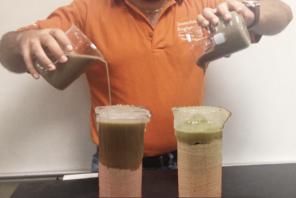
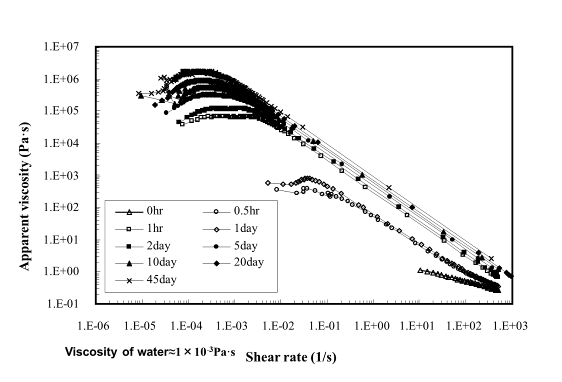
|
Yoon, 2011 |
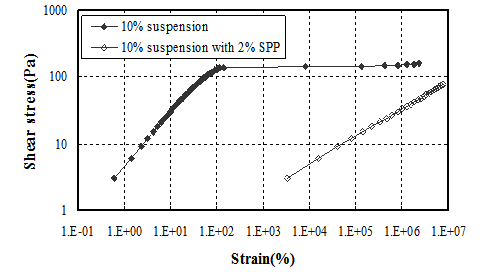
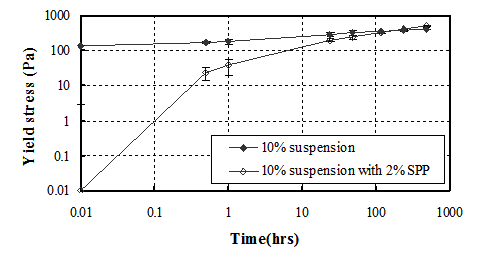
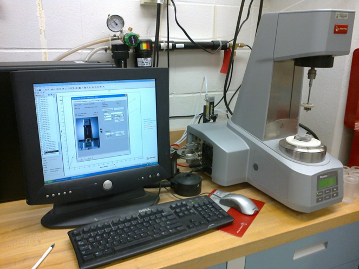


|
http://www.caee.utexas.edu/prof/El_Mohtar/Home_files/index.htm |